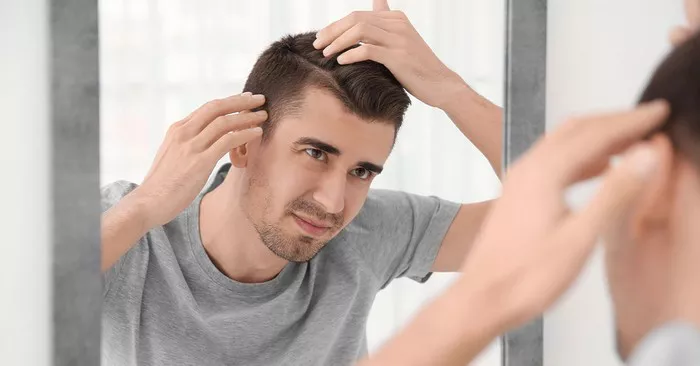Testosterone therapy is a common and often essential component of the gender transition process for many transgender men (FTM). While testosterone can bring about many desired changes, such as a deeper voice, increased muscle mass, and the development of facial hair, it can also lead to some less welcome side effects. One of the most distressing for many individuals is hair loss. Understanding how to manage and prevent hair loss while on testosterone can help alleviate some of the anxiety and provide a sense of control during the transition process.
Understanding the Causes of Hair Loss on Testosterone
Hormonal Changes
Testosterone is converted into dihydrotestosterone (DHT) in the body, a potent androgen that can shrink hair follicles, leading to hair thinning and eventual loss. This process, known as androgenetic alopecia, is similar to male pattern baldness in cisgender men. The increased levels of testosterone in FTM individuals can accelerate this process.
Genetic Predisposition
Genetics play a significant role in determining who will experience hair loss. If male relatives, such as fathers, uncles, or grandfathers, experienced hair loss, there is a higher likelihood that FTM individuals will experience similar patterns of hair thinning or loss.
Other Contributing Factors
Several other factors can contribute to hair loss, including stress, diet, overall health, and the presence of certain medical conditions. It’s essential to consider these aspects as part of a comprehensive approach to preventing hair loss.
Preventive Measures and Treatment Options
1. Medical Interventions
Finasteride and Dutasteride
These medications are DHT blockers that can help prevent hair loss by inhibiting the enzyme that converts testosterone to DHT. They are commonly prescribed to cisgender men for male pattern baldness and can be effective for FTM individuals as well. However, it is crucial to consult with a healthcare provider before starting these medications to understand the potential risks and benefits.
Minoxidil
Minoxidil, commonly known by the brand name Rogaine, is an over-the-counter topical treatment that can help stimulate hair growth and slow down hair loss. It is applied directly to the scalp and can be used in conjunction with other treatments for better results.
Platelet-Rich Plasma (PRP) Therapy
PRP therapy involves injecting the patient’s own platelets into the scalp to stimulate hair growth. This treatment has shown promise in promoting hair regrowth and improving hair density.
2. Lifestyle and Dietary Adjustments
Balanced Diet
A diet rich in vitamins and minerals, particularly those known to support hair health, can make a significant difference. Key nutrients include:
- Biotin: Found in eggs, nuts, and whole grains, biotin is essential for healthy hair growth.
- Iron: Anemia or low iron levels can contribute to hair loss. Red meat, leafy greens, and legumes are excellent sources of iron.
- Vitamin D: Sun exposure and foods like fatty fish and fortified dairy products can help maintain adequate vitamin D levels.
- Zinc: Zinc supports hair tissue growth and repair. It can be found in shellfish, meat, and legumes.
Hydration
Staying well-hydrated is vital for overall health and can help maintain healthy hair. Aim to drink at least 8 glasses of water a day.
Stress Management
Stress can exacerbate hair loss, so incorporating stress management techniques such as meditation, yoga, or regular exercise can be beneficial.
3. Hair Care Practices
Gentle Hair Care
Avoiding harsh hair treatments and styles that pull on the hair can help prevent further damage. Opt for gentle, sulfate-free shampoos and conditioners, and avoid excessive heat styling.
Scalp Massage
Regular scalp massages can improve blood circulation to the hair follicles, promoting hair growth. Using essential oils like rosemary or peppermint oil during the massage can enhance the benefits.
Protective Hairstyles
Choosing hairstyles that minimize tension on the scalp and hair can help prevent breakage and hair loss. Loose braids, buns, or letting hair down are good options.
4. Psychological Support
Experiencing hair loss can be emotionally challenging. Seeking support from friends, family, or professional counselors can help manage the emotional impact. Joining support groups, either in person or online, can provide a sense of community and shared experiences.
See Also: How to Prevent Hair Loss During Exercise: A Comprehensive Guide
Professional Medical Consultation
Regular Check-Ups
Regular consultations with a healthcare provider who understands transgender health issues are crucial. They can monitor hormone levels, assess hair health, and make necessary adjustments to the treatment plan.
Dermatologist Visits
A dermatologist specializing in hair loss can provide targeted treatments and recommendations based on individual needs. They can perform scalp analyses, recommend appropriate treatments, and monitor progress.
Endocrinologist Guidance
Working with an endocrinologist who specializes in transgender care ensures that hormone therapy is optimized for overall health and minimizes unwanted side effects, including hair loss.
Alternative Treatments
Natural Supplements
Some natural supplements claim to support hair health, such as saw palmetto, pumpkin seed oil, and nettle root. While the efficacy of these supplements can vary, they may be worth discussing with a healthcare provider.
Laser Therapy
Low-level laser therapy (LLLT) is a non-invasive treatment that uses red light to stimulate hair growth. It can be used at home with devices such as laser combs or caps.
Hair Transplantation
For those experiencing significant hair loss, hair transplantation may be an option. This surgical procedure involves transferring hair follicles from one part of the body to the thinning or balding areas.
Conclusion
Preventing hair loss while on testosterone for FTM individuals requires a multi-faceted approach. Understanding the causes, implementing preventive measures, and seeking professional medical advice are all critical steps. With the right combination of treatments, lifestyle adjustments, and support, it is possible to manage hair loss effectively and maintain healthy hair during the transition process. As with any medical concern, individual responses to treatments can vary, so it is essential to work closely with healthcare providers to develop a personalized plan that meets specific needs and goals.


